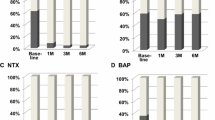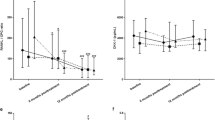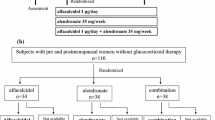Abstract
Bisphosphonates are potent inhibitors of osteoclastic activity and reduce the disease-related skeletal complications when they are used in combination with chemotherapy in patients with multiple myeloma (MM). Pamidronate also inhibits apoptosis of primary osteoblastic cells and probably induces apoptosis on human MM cells and osteoclasts. It has been reported that interferon-alpha (IFN-α) decreases bone resorption and that low doses of IFN-α result in a significant increase in serum osteocalcin (OSC). The aim of this study was to determine the effects of pamidronate treatment on biochemical markers of bone resorption [cross-linked N-telopeptides of type I collagen (NTx)], bone formation [bone alkaline phosphatase (BAP) and OSC], disease activity [β2-microglobubin, CRP, paraprotein], and interleukin-6 (IL-6) in patients with MM in plateau phase under IFN-α maintenance. The above parameters were evaluated in 28 patients (13 M, 15 F, median age 70 years) during maintenance treatment, before the addition of pamidronate and after 1, 3, 6, 9, 12, and 14 months of the combined therapy. The addition of pamidronate to maintenance treatment resulted in a significant reduction of NTx, IL-6, β2-microglobulin, CRP from the 3rd month and para-protein from the 6th month of treatment, whereas BAP and OSC were significantly increased from the 6th month. These changes continued during the 14-month follow-up of the combined treatment. Multivariate analysis showed a significant negative correlation between changes of BAP and OSC and the patients' age. The greater increase of the bone for-mation markers was observed in younger patients. These results suggest that, in addition to the inhibition of osteoclastic activity, pamidronate in combination with IFN-α was shown to induce bone formation in patients with MM in the plateau phase.
Similar content being viewed by others
References
Mundy GR (1998) Myeloma bone disease. Eur J Cancer 34:246–251
Anderson KC, Lust JA (1999) Role of cytokines in multiple myeloma. Semin Hematol 36 (suppl 31):14–20
Suda T, Nakamura I, Jimi E, Takahashi N (1997) Regulation of osteoclast function. J Bone Miner Res 12:869–879
Belch AR, Bergsagel DE, Wilson K, O'Reilly S, Wilson J, Sutton D, Pater J, Johnston D, Zee B (1991) Effect of daily etidronate on the osteolysis of multiple myeloma. J. Clin Oncol 9:1397–1402
Lahtinen R, Laakso M, Palva I, Virkkunen P, Elomaa I (1992) Randomized, placebo-controlled multicentre trial of clodronate in multiple myeloma. Finnish Leukaemia Group. Lancet 340:1049–1052
Berenson JR, Lichtenstein A, Porter L, Dimopoulos MA, Bordoni R, George S, Lipton A, Keller A, Ballester O, Kovacs MJ, Blacklock HA, Bell R, Simeone FJ, Reitsma DJ, Heffernar M, Seaman J, Knight RD (1996) Efficacy of pamidronate in reducing the skeletal events in patients with advanced multiple myeloma. Myeloma Aredia Study Group. N Engl J Med 334:488–493
McCloskey EV, MacLennan IC, Drayson MT, Chapman C, Dunn J, Kanis JA (1998) A randomized trial of the effect of clodronate on skeletal morbidity in multiple myeloma. MCR Working Party on Leukaemia in Adults. Br J Haematol 100:317–325
Brincker H, Westin J, Abildgaard N, Gimsing P, Turesson I, Hedenus M, Ford J, Kandra A (1998) Failure of oral pamidronate to reduce skeletal morbidity in multiple myeloma: a double-blind placebo-controlled trial. Danish-Swedish cooperative study group. Br J Haematol 101:280–286
Berenson JR, Lichtenstein A, Porter L, Dimopoulos MA, Bordoni R, George S, Lipton A, Keller A, Ballester O, Kovacs MJ, Blacklock HA, Bell R, Simeone FJ, Reitsma DJ, Heffernar M, Seaman J, Knight RD, Myeloma Aredia Study Group (1998) Long-term pamidronate treatment of advanced multiple myeloma patients reduces skeletal events. J Clin Oncol 16:593–602
Aparicio A, Gardner A, Tu Y, Savage A, Berenson J, Lichtenstein A (1998) In vitro cytoreductive effects on multiple myeloma cells induced by bisphosphonates. Leukemia 12:220–229
Ludwig H, Cohen AM, Polliack A, Huber H, Nachbaur D, Senn HJ, Morant R, Eckhardt S, Gunczler P, Seewann SL, Schuller J, Rhyner K, Cavalli F, Fritz E (1995) Interferonalpha for induction and maintenance in multiple myeloma: results of two multicentre randomized trials and summary of other studies. Ann Oncol 6:467–476
Fritz E, Ludwig H (2000) Interferon-alpha treatment in multiple myeloma: meta-analysis of 30 randomised trials among 3948 patients. Ann Oncol 11:1427–1436
Goodman GR, Dissanayake IR, Gorodetsky E, Zhou H, Ma YE, Jee WS, Epstein S (1999) Interferon-alpha, unlike interferon-gamma, does not cause bone loss in the rat. Bone 25:459–463
Withold W (1996) Monitoring of bone turnover biological, preanalytical and technical criteria in the assessment of biochemical markers. Eur J Clin Chem Clin Biochem 34:785–799
Schneider DL, Barrett-Connor EL (1997) Urinary N-telopeptide levels discriminate normal osteopenic and osteoporotic bone mineral density. Arch Intern Med 157:1241–1245
Withold W, Friedrich W, Reinauer H (1996) Comparison of biochemical markers of bone resorption in patients with metabolic and malignant bone diseases. Ann Clin Biochem 33:421–427
Chronic Leukaemia-Myeloma Task Force: National Cancer Institute Proposed guidelines for protocol studies. II. Plasma cell myeloma. Cancer Chemother Rep 4:145–158
Lipton A, Demers L, Curley E, Chinchilli V, Gaydos L, Hortobagyi G, Theriault R, Clemens D, Costa L, Seaman J, Knight R (1998) Markers of bone resorption in patients treated with pamidronate. Eur J Cancer 34:2021–2026
Rosen HN, Moses AC, Garber J, Ross DS, Lee SL, Greenspan SL (1998) Utility of biochemical markers of bone turnover in the follow-up of patients treated with bisphosphonates. Calcif Tissue Int 63:363–368
Tsuda-Futami E, Shioi A, Jono S, Inaba M, Nishizawa Y, Morii H (1998) Lymp0hoblastoid interferon-alpha downregulates parathyroid hormone (PTH)/PTH-related peptide (PTHrP) receptor expression in human osteoblastic cells (Saos-2). Bone 23:205–211
Roodman GD (1999) Cell biology of the osteoclast. Exp Hematol 27:1229–1241
Linkhart TA, Linkhart SG, McCharles DC, Long DL, Strong DD (1991) Interleukin-6-messager, RNA expression and interleukin-6 protein secretion in cells isolated from normal human bone: regulation by interleukin-1. J Bone Miner Res 6:1285–1294
Ohsaki Y, Takahashi S, Scarcez T, Demulder A, Nishihara T, Williams R, Roodman GD (1992) Evidence for an autocrine/ paracrine role for interleukin-6 in bone resorption by giant cells from giant cell tumors of bone. Endocrinology 131:2229–2234
Klein B, Zhang XG, Lu ZY, Bataille R (1995) Interleukin-6 in human multiple myeloma. Blood 85:863–872
Hallek M, Bergsagel PL, Anderson KC (1998) Multiple myeloma: increasing evidence for a multistep transformation process. Blood 91:3–21
Kunzmann V, Bauer E, Feurle J, Weibinger F, Tony HP, Wilhelm M (2000) Stimulation of y δ T cells by aminobisphosphonates and induction of antiplasma cell activity in multiple myeloma. Blood 96:384–392
Minami R, Muta K, Ilseung C, Abe Y, Nishimura J, Nawata H (2000) Interleukin-6 sensitizes multiple myeloma cell lines for apoptosis induced by interferon-alpha. Exp Hematol 28:244–255
Terpos E, Palermos J, Tsionos K, Anargyrou K, Viniou N, Papassavas P, Meletis J, Yataganas X (2000) Effect of pamidronate administration on markers of bone turnover and disease activity in multiple myeloma. Eur J Haematol 65:331–336
Savage AD, Belson DJ, Vescio RA, Lichtenstein A, Berenson J (1996) Pamidronate reduces IL-6 production by bone marrow stroma from multiple myeloma patients (abstract). Blood 88 (suppl 1):105a
Plotkin LI, Weinstein RS, Parfitt AM, Roberson PK, Manolagas SC, Bellido T (1999) Prevention of osteocyte and osteoblast apoptosis by bisphosphonates and calcitonin. J Clin Invest 104:1363–1374
Abildgaard N, Rungby J, Glerup H, Brixen K, Kassem M, Brincker H, Heickendorff L, Eriksen EF, Nielsen JL (1998) Long-term oral pamidronate treatment inhibits osteoclastic bone resorption and bone turnover without affecting osteoblastic function in multiple myeloma. Eur J Haematol 62:128–134
Carlson K, Larsson A, Simonsson B, Turesson I, Westin J, Ljunghall S (1999) Evaluation of bone disease in multiple myeloma: a comparison between the resorption markers urinary deoxypyridinoline/creatinine (DPD), and serum ICTP, and an evaluation of the DPD/osteocalcin and ICTP/ osteocalcin ratios. Eur J Haematol 62:300–306
Author information
Authors and Affiliations
Rights and permissions
About this article
Cite this article
Terpos, E., Palermos, J., Viniou, N. et al. Pamidronate increases markers of bone formation in patients with multiple myeloma in plateau phase under interferon-alpha treatment. Calcif Tissue Int 68, 285–290 (2001). https://doi.org/10.1007/BF02390835
Received:
Accepted:
Issue Date:
DOI: https://doi.org/10.1007/BF02390835




